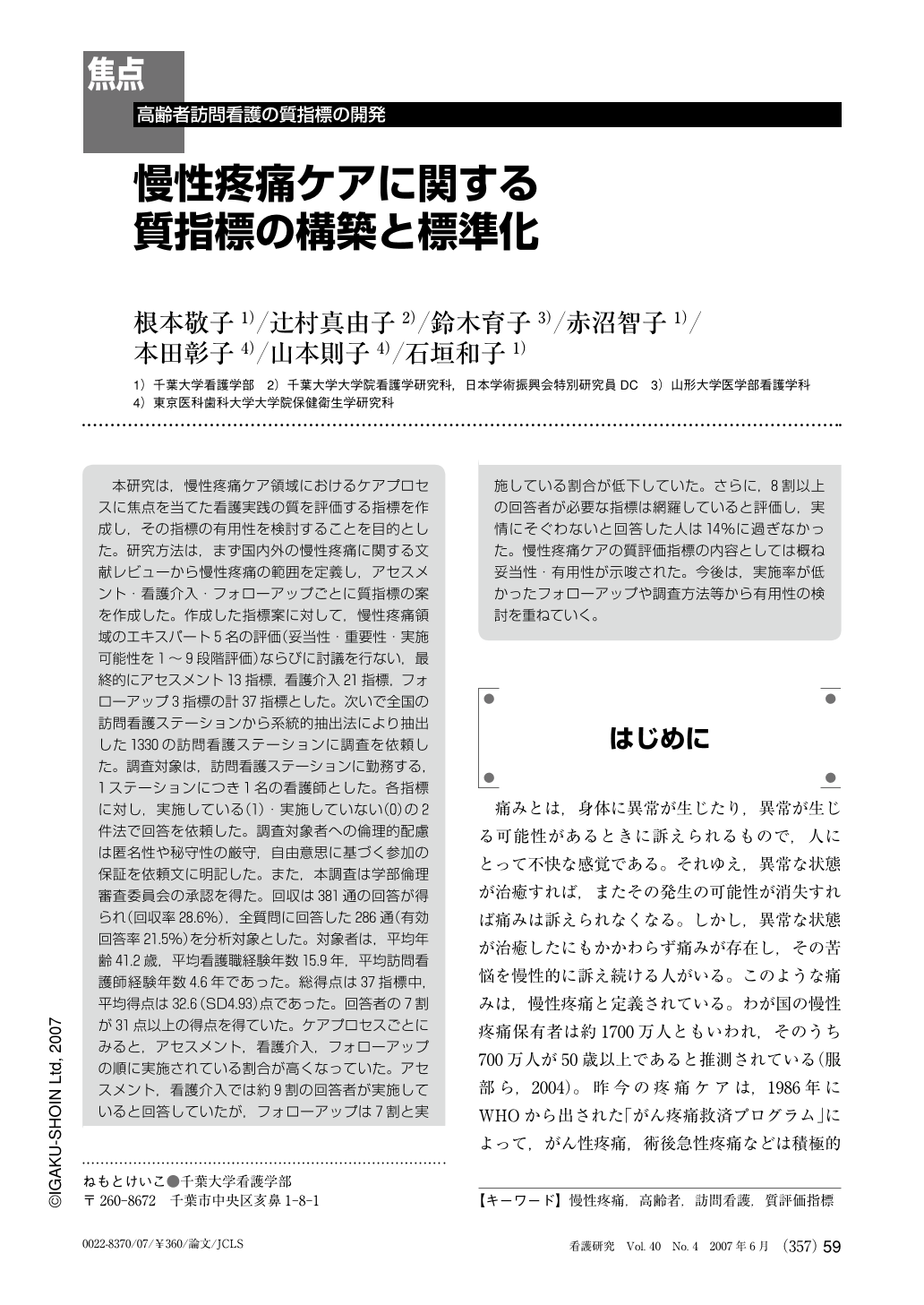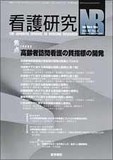Japanese
English
- 有料閲覧
- Abstract 文献概要
- 1ページ目 Look Inside
- 参考文献 Reference
本研究は,慢性疼痛ケア領域におけるケアプロセスに焦点を当てた看護実践の質を評価する指標を作成し,その指標の有用性を検討することを目的とした。研究方法は,まず国内外の慢性疼痛に関する文献レビューから慢性疼痛の範囲を定義し,アセスメント・看護介入・フォローアップごとに質指標の案を作成した。作成した指標案に対して,慢性疼痛領域のエキスパート5名の評価(妥当性・重要性・実施可能性を1~9段階評価)ならびに討議を行ない,最終的にアセスメント13指標,看護介入21指標,フォローアップ3指標の計37指標とした。次いで全国の訪問看護ステーションから系統的抽出法により抽出した1330の訪問看護ステーションに調査を依頼した。調査対象は,訪問看護ステーションに勤務する,1ステーションにつき1名の看護師とした。各指標に対し,実施している(1)・実施していない(0)の2件法で回答を依頼した。調査対象者への倫理的配慮は匿名性や秘守性の厳守,自由意思に基づく参加の保証を依頼文に明記した。また,本調査は学部倫理審査委員会の承認を得た。回収は381通の回答が得られ(回収率28.6%),全質問に回答した286通(有効回答率21.5%)を分析対象とした。対象者は,平均年齢41.2歳,平均看護職経験年数15.9年,平均訪問看護師経験年数4.6年であった。総得点は37指標中,平均得点は32.6(SD4.93)点であった。回答者の7割が31点以上の得点を得ていた。ケアプロセスごとにみると,アセスメント,看護介入,フォローアップの順に実施されている割合が高くなっていた。アセスメント,看護介入では約9割の回答者が実施していると回答していたが,フォローアップは7割と実施している割合が低下していた。さらに,8割以上の回答者が必要な指標は網羅していると評価し,実情にそぐわないと回答した人は14%に過ぎなかった。慢性疼痛ケアの質評価指標の内容としては概ね妥当性・有用性が示唆された。今後は,実施率が低かったフォローアップや調査方法等から有用性の検討を重ねていく。
The purpose of this study was to develop quality indicators (QIs) to evaluate home nursing practices for chronic pain management. First we defined chronic pain from the literature review, and developed an indicator pool on the assessment, nursing intervention, and follow-up for chronic pain management. Five clinical experts on chronic pain evaluated the QIs in terms of validity, importance and feasibility in the 9-point Likert scale, and the QIs were finalized in a discussion among the five experts and researchers. The QIs for chronic pain management consist of 13 indicators on assessments, 20 indicators on nursing intervention, and 3 indicators on follow-up, totaling 37 items. We distributed questionnaires that include the 37 QIs on chronic pain management to 1330 home nursing stations. One nurse from each station was asked to answer the questionnaire. A total of 381 questionnaires (28.6%) were returned, and 286 fully completed questionnaires (21.5%) were analyzed. The average age of the respondents was 41.2 years old, with average clinical experience of 15.9 years and 4.6 years of experience in home nursing. The average total score was 32.6 (SD 4.93) where the perfect score was 37. Approximately 70% of respondents scored 31 or more. Approximately 90% of respondents practiced the QIs related to assessment and nursing intervention, whereas only about 70% practiced the QIs related to follow-up. More than 80% of the respondents answered that the QIs cover essential aspects of chronic pain management while only 14% evaluated that they did not fit clinical practice. Thus the QIs were generally shown to have content validity and applicability. We are going to further examine the utility of chronic pain QIs.

Copyright © 2007, Igaku-Shoin Ltd. All rights reserved.


